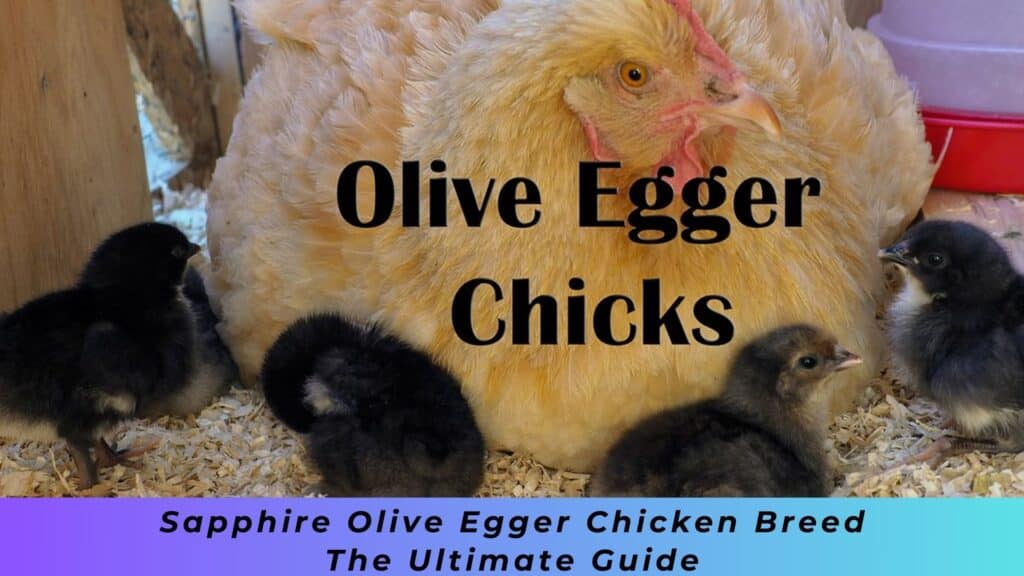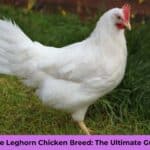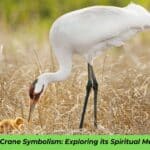Discover the allure of Sapphire Olive Egger chickens, a fascinating hybrid breed that’s capturing the hearts of backyard poultry enthusiasts.
These unique birds offer a perfect blend of beauty, productivity, and charm. In this comprehensive guide, we’ll explore everything you need to know about this captivating breed, from their striking appearance to their egg-laying prowess.
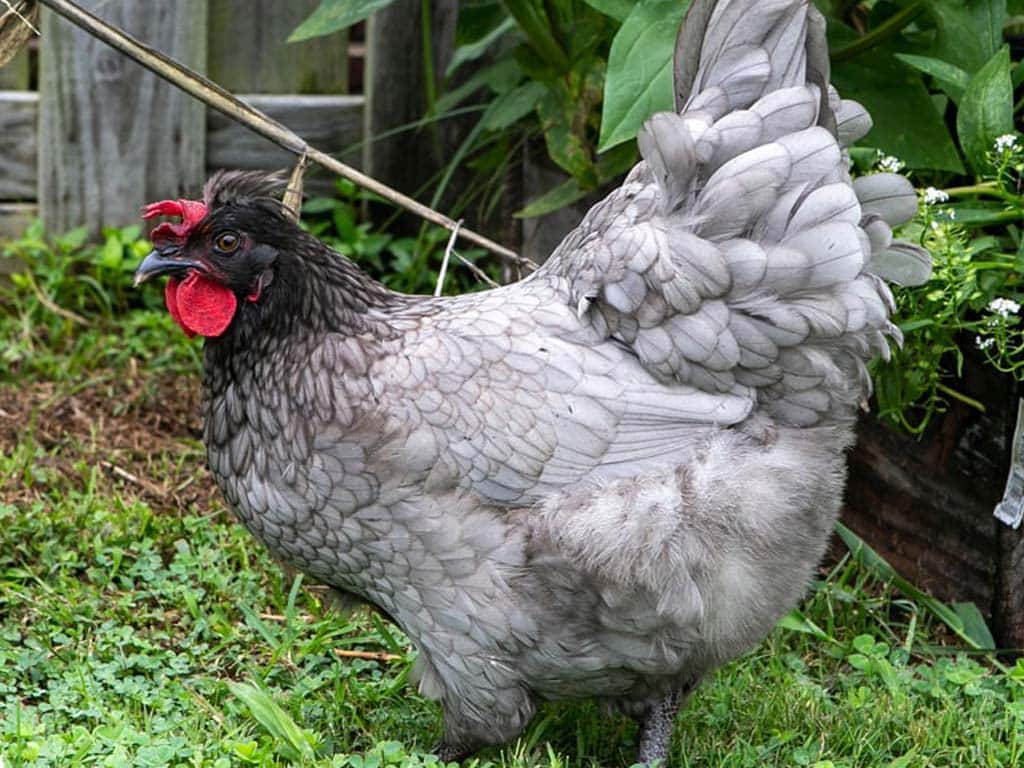
Origins and Breeding: The Birth of the Sapphire Olive Egger
The Fascinating History Behind Sapphire Olive Egger
Sapphire Olive Egger chickens have a rich history rooted in the pursuit of colorful eggs. These birds are the result of careful crossbreeding between blue egg-laying breeds and dark brown egg layers. The journey began with the introduction of the Araucana and Ameraucana breeds to the poultry world, known for their blue eggs.
“The creation of Olive Eggers was a stroke of genetic genius, combining the best traits of multiple breeds to produce a chicken that lays truly unique eggs.” – Poultry expert, Dr. Sarah Cluckington
Sapphire Olive Egger: A Specialized Variant
The Sapphire Olive Egger takes this concept a step further. This specialized variant typically involves crossing a blue egg-laying breed (often a Cream Legbar or Ameraucana) with a dark brown egg layer (such as a Marans or Welsummer). The “Sapphire” in their name often comes from incorporating the Sapphire Gem or Blue Plymouth Rock into the breeding mix, which contributes to their unique plumage.
Hybrid or Heritage? Unraveling the Sapphire Olive Egger’s Breed Status
It’s important to note that Sapphire Olive Eggers are considered a hybrid breed. They’re not recognized by the American Poultry Association (APA) as a standardized breed. This hybrid status means:
- They offer hybrid vigor, often resulting in hardier birds
- Their offspring may not consistently exhibit the same traits
- They’re prized for their unique characteristics rather than conformity to a breed standard
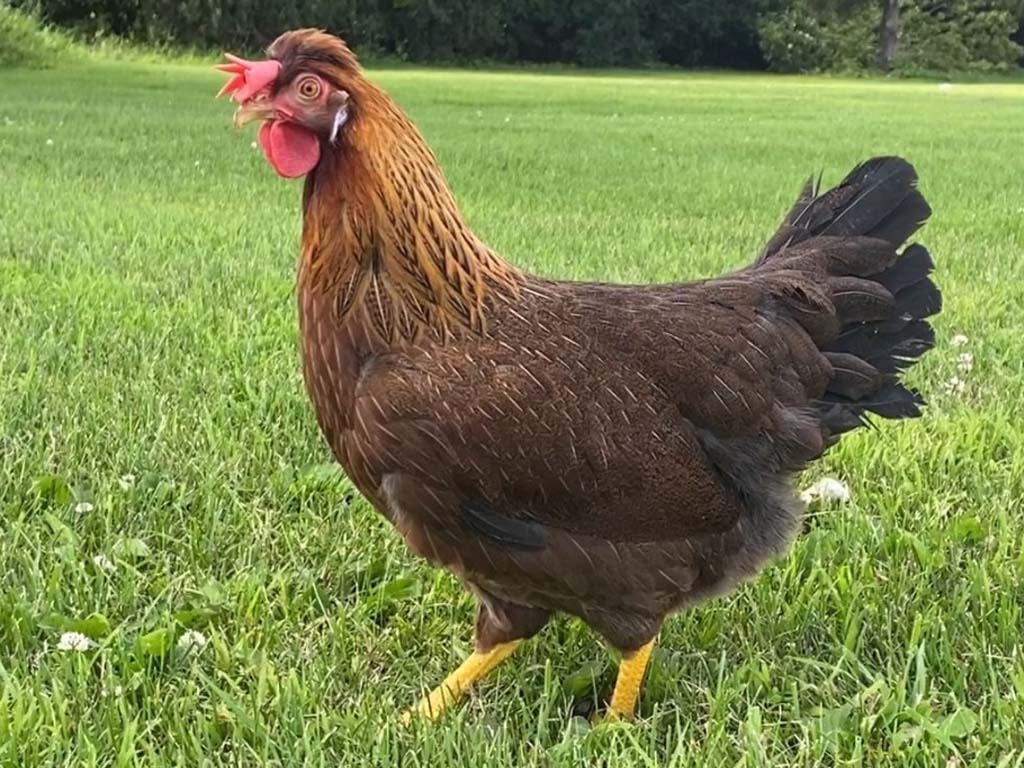
Appearance and Physical Characteristics of the Sapphire Olive Egger
Distinctive Plumage and Coloration of Sapphire Olive Egger
Sapphire Olive Eggers boast a stunning appearance that sets them apart from other chickens:
- Feather color: Typically a beautiful blue or lavender hue, often with lacing or patterns
- Skin color: Usually white or yellow, depending on the parent breeds
- Beak: Often dark in color, complementing their overall appearance
Check this out 24 Yellow Birds In Ohio With Photos
Size and Weight Variations in Sapphire Olive Egger
These birds fall into the medium-size category for chickens:
| Gender | Average Weight |
| Hens | 5-6 lbs |
| Roosters | 6-7 lbs |
Comb and Wattle Features of the Sapphire Olive Egger
Sapphire Olive Eggers typically inherit comb types from their parent breeds:
- Single combs are common
- Pea combs or rose combs may occur, depending on the breeding
- Wattles are usually medium-sized and red
Leg Color and Characteristics
- Leg color can vary, often slate blue or green
- Clean-legged (no feathering on legs)
- Four toes on each foot
The Prized Eggs of Sapphire Olive Egger: A Rainbow in Your Nest Box
The Allure of Sapphire Olive Egger Eggs
The main attraction of Sapphire Olive Eggers is their unique egg color. These birds lay eggs in various shades of olive green, ranging from light sage to deep olive. The exact shade can vary depending on the individual hen and her specific genetic makeup.

Egg Size and Production Rates
- Egg size: Medium to large
- Production rate: 3-4 eggs per week on average
- Annual production: Approximately 200-250 eggs per year
Check this out How and Where Do Geese Sleep? The Secrets of Goose Slumber
Factors Affecting Egg Color Intensity
Several factors can influence the intensity of the olive color:
- Genetics of the parent breeds
- Diet and nutrition
- Stress levels
- Age of the hen (color may fade slightly as the hen ages)
Nutritional Value Compared to Other Chicken Eggs
Olive Egger eggs are not just beautiful; they’re also nutritious. While the nutritional content is similar to other chicken eggs, some studies suggest that blue and green-shelled eggs may have slightly higher levels of antioxidants.
Behavioral Traits and Temperament of Sapphire Olive Egger
Personality Profile: Are They Friendly?
Sapphire Olive Eggers are known for their pleasant dispositions:
- Generally friendly and docile
- Often curious and interactive with humans
- Can be slightly flighty or skittish if not handled regularly
Interaction with Other Chicken Breeds
These birds typically do well in mixed flocks:
- Non-aggressive nature makes them good flock members
- May be lower in the pecking order due to their gentle nature
- Adapt well to various social situations
Check this out Finches In Florida – The Complete Guide To Florida Finches
Broodiness Tendencies
Sapphire Olive Eggers are not known for being particularly broody:
- Occasional broodiness may occur but is not common
- Generally reliable egg producers without frequent laying interruptions
Noise Levels and Suitability for Urban Settings
While not the quietest breed, they’re not excessively noisy:
- Hens make typical chicken vocalizations
- Roosters crow, as expected, but are not known for being unusually loud
- Generally suitable for suburban settings, but check local regulations
Care and Management: Keeping Your Sapphire Olive Egger Happy and Healthy
Housing Requirements and Space Needs
Proper housing is crucial for the health and productivity of your Sapphire Olive Eggers:
- Coop space: Minimum 4 square feet per bird
- Run space: 8-10 square feet per bird
- Roosting space: 8-10 inches of roosting bar per bird
- Nesting boxes: 1 box per 3-4 hens
Feeding Guidelines for Optimal Health and Egg Production
A balanced diet is essential for maintaining health and egg production:
- Layer feed: High-quality layer feed with 16-18% protein
- Calcium supplement: Offer crushed oyster shells or eggshells
- Fresh water: Clean, fresh water available at all times
- Treats: Limited treats (10% of diet) like fruits, vegetables, and insects
Climate Adaptability and Cold Hardiness
Sapphire Olive Eggers are generally adaptable to various climates:
- Cold hardy: Their compact bodies and small combs make them resistant to frostbite
- Heat tolerance: Moderate, but provide shade and cool water during hot weather
Common Health Issues and Prevention Strategies
While generally healthy, be aware of these potential issues:
- Respiratory infections: Ensure proper ventilation in the coop
- Egg binding: Provide adequate calcium and monitor for signs of distress
- External parasites: Regular dust baths and inspections can prevent mite and lice infestations
- Internal parasites: Implement a deworming schedule as recommended by a veterinarian

Breeding Sapphire Olive Egger: Preserving the Magic
Genetics Behind the Sapphire Olive Egger
Breeding Sapphire Olive Eggers involves understanding the genetics of egg color and plumage:
- Blue egg gene (O) from Ameraucana or Cream Legbar parent
- Dark brown egg gene from Marans or Welsummer parent
- Blue plumage genes from Sapphire Gem or Blue Plymouth Rock
Check this out Herons In Michigan – The Complete Guide To 8 Michigan Herons
Choosing Breeding Stock
Select birds with desirable traits:
- Hens with the best olive egg color
- Birds with good overall health and vitality
- Roosters and hens with appealing plumage color and pattern
Maintaining Breed Characteristics
- Keep detailed records of breeding pairs and offspring
- Regularly assess egg color and production in offspring
- Cull birds that don’t meet desired standards
Challenges in Breeding Programs
- Inconsistency in offspring due to hybrid nature
- Balancing egg color with other desirable traits
- Avoiding inbreeding while maintaining desired characteristics

Performance as Dual-Purpose Birds: More Than Just Pretty Eggs
Egg-Laying Capabilities
Sapphire Olive Eggers excel in egg production:
- Start laying at 20-24 weeks of age
- Consistent layers, even through winter months
- Egg production may decrease after 2-3 years
Meat Production Potential
While not primarily bred for meat, they can serve as dual-purpose birds:
- Medium-sized birds provide a decent amount of meat
- Flavor is generally good, though not as rich as dedicated meat breeds
- Slower growing compared to commercial meat breeds
Comparing with Other Dual-Purpose Breeds
| Breed | Egg Production | Meat Quality | Hardiness |
| Sapphire Olive Egger | High | Moderate | Good |
| Rhode Island Red | High | Good | Excellent |
| Orpington | Moderate | Excellent | Excellent |
| Sussex | Good | Good | Good |
Check this out How Long Does a Quail Live? The Vulnerable Lives Of Quail
Sapphire Olive Egger in Sustainable Agriculture: A Green Choice
Role in Small-Scale Farming
These birds are well-suited for small farms and homesteads:
- Efficient feed-to-egg conversion
- Adaptable to free-range or confined settings
- Produce unique eggs that can command premium prices
Contribution to Genetic Diversity
By keeping Sapphire Olive Eggers, you’re helping to:
- Preserve unique genetic traits
- Support biodiversity in poultry
- Encourage the development of new and interesting chicken varieties
Eco-Friendly Aspects of Raising This Breed
- Excellent foragers, reducing feed costs and environmental impact
- Hardy nature reduces the need for medical interventions
- Dual-purpose potential minimizes waste
Getting Started with Sapphire Olive Egger: Your Next Steps
Where to Source Chicks or Adult Birds
- Specialty hatcheries that focus on rare and hybrid breeds
- Local breeders or poultry shows
- Online poultry marketplaces (ensure reputable sources)
Integration into Existing Flocks
- Quarantine new birds for 2-4 weeks before introducing
- Introduce gradually, allowing supervised interaction
- Provide enough space and resources to reduce competition
Cost Considerations
- Chicks: $5-$10 each, depending on source
- Adult birds: $20-$40 each
- Factor in costs for housing, feed, and supplies
Legal Considerations for Backyard Chicken Keeping
- Check local zoning laws and regulations
- Be aware of any restrictions on flock size or roosters
- Consider neighbors and community guidelines
Conclusion: Is the Sapphire Olive Egger Right for You?
Sapphire Olive Eggers offer a unique combination of beauty, productivity, and personality. They’re ideal for:
- Poultry enthusiasts looking for colorful eggs
- Small-scale farmers wanting a dual-purpose bird
- Families seeking friendly, low-maintenance chickens
Consider your space, local regulations, and poultry-keeping goals when deciding if this dazzling breed is the right fit for your flock.
FAQs About Sapphire Olive Egger
- How long do Sapphire Olive Eggers live?
- On average, 5-8 years with proper care.
- Can Sapphire Olive Eggers fly?
- They have limited flying abilities but can clear a 4-foot fence.
- Do they require special care in winter?
- While cold-hardy, provide a draft-free coop and monitor for frostbite on combs.
- How can I ensure the best olive egg color?
- Breed from hens laying the darkest olive eggs and roosters from dark egg lines.
- Are Sapphire Olive Eggers good with children?
- Yes, their friendly nature makes them suitable for families with children.
By embracing the Sapphire Olive Egger, you’re not just adding chickens to your backyard – you’re inviting living works of art that will provide you with beautiful eggs and delightful companionship for years to come.

